19 May Our Lake Titicaca trip
Our Lake Titicaca trip was one of the best we’ve had in South America. We fell in love with Copacabana, a quiet town where we relaxed in hammock-studded gardens accompanied by alpacas, soaking up the sun and views of the never-ending lake. To explore Titicaca’s treasures, we took boat trips to Isla del Sol and visited Peru’s floating islands made of reeds, where families in neon outfits live in thatched houses.
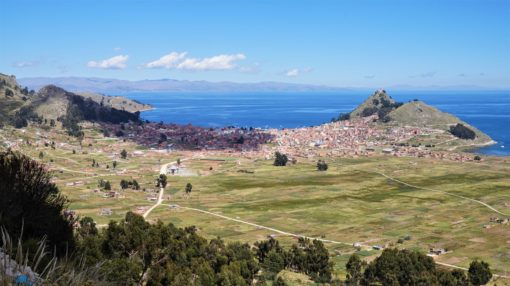
Planning a trip to Puno and Lake Titicaca? Skip straight to these useful sections:
- Lake Titicaca travel costs
- Tips for booking Lake Titicaca tours
- Where to stay Lake Titicaca
- Getting to and from Lake Titicaca
Highlights of our Lake Titicaca trip
Titicaca is the largest lake in South America and the highest navigable lake in the world, with an elevation of 3,810 metres. Set in the stunning Andes, Titicaca straddles the Bolivia and Peru border and its shimmering surface is dotted with 41 islands. From La Paz, we visited Lake Titicaca Bolivia then crossed the border into Peru by bus, stopping to do a Uros floating islands tour before moving on to Cusco. Here are the highlights from our Lake Titicaca trip, from chilling in Copacabana to hiking on remote islets and visiting the Uros people on the famous floating reed islands.
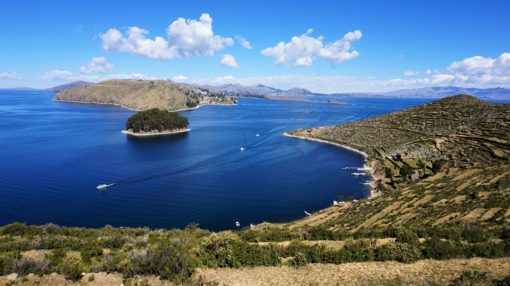
Isla del Sol Copacabana
After the hectic bustle of La Paz, we fell instantly in love with Copacabana, a peaceful town set on the shores of Lake Titicaca. From the gardens of our hotel, La Cupula, we could watch boats bob in the harbour and the sun set over the water, which stretches into the horizon and is so vast it looks like an ocean.
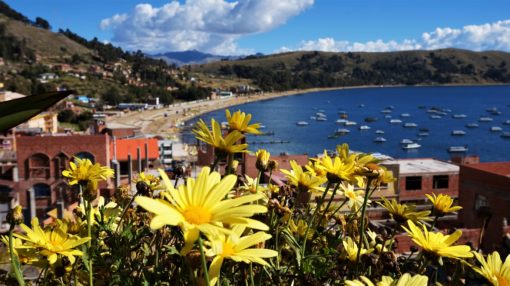
The few streets in Copacabana may be filled with bars, restaurants and tour companies, but we found solace at La Cupula and enjoyed beans on toast from Condor Café and vegan sandwiches from Baguette About It. At night, the temperature dropped and we snuggled up with complimentary hot water bottles.
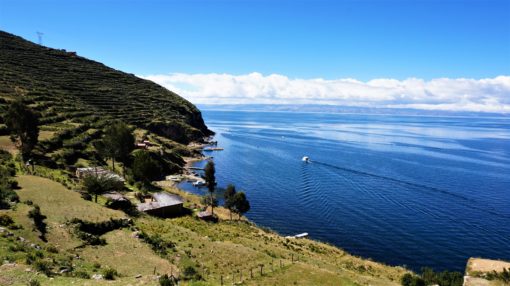
One of the main things to do in Copacabana is take a boat trip to one of the largest Titicaca Islands, which is about an hour away and named Sun Island, or Isla del Sol in Spanish. After mooring, we made the hour-long hike across the rocky landscape to a small village, complete with donkeys. Along the way we passed local people selling alpaca-wool jumpers and kids wanting to pose with baby alpacas for tourist dollars. The coastal path provided sweeping views of the lake and neighbouring Moon Island.
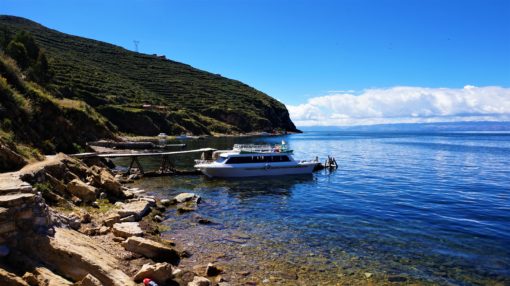
Isla del Sol Titicaca features around 180 pre-Incan ruins and is named after a sun god, who the Incas believed was born here. There are no vehicles or paved roads on Sun Island Lake Titicaca and it feels like a time capsule. At the moment, tourists can only visit the southern end of the island, the north is off limits, but there are a cluster of cute hostels in the village where you can stay overnight.
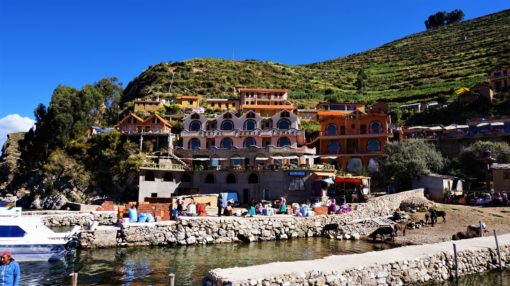
Uros floating islands
Leaving Copacabana, we took the bus to Lake Titicaca Peru. In just four hours we arrived in the main tourist hub, Puno, which is much larger and a lot less scenic than Copacabana. From here, we booked an Uros Islands tour for the day through our hotel to see the most famous sight on Lake Titicaca.
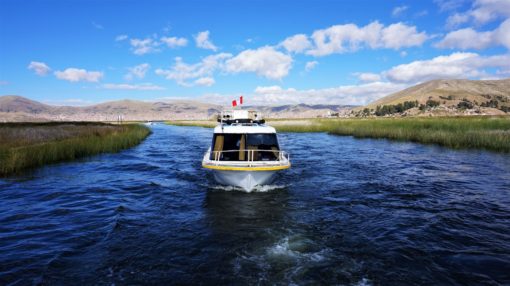
So, what exactly are the Uros islands? Picture floating islets made from a carpet of reeds, dotted with thatched huts home to the Uros people, who were thought to have originated from the Amazon. They moved to Bolivia centuries ago and after encountering hostility from locals, constructed islands from the lake’s tough totora reeds and anchored them in the middle of the lake. Today, hundreds of families still live on the islands, making a living from tourist visits, homestays, fishing and selling handicrafts.
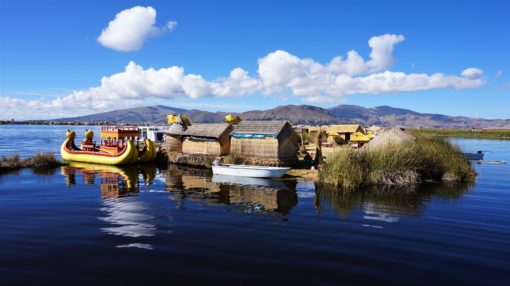
We’d heard that trips to the Lake Titicaca reed islands were incredibly touristy so we had mixed feelings about visiting, but the tour turned out to be better than we thought. Any islands that want to remain private are left alone, while authorities control boats to make sure they’re sent evenly to the islands that want to receive tourists. Yes, there were lots of handicrafts on sale, but we didn’t feel pressured to buy any and still contributed by paying for a ride on one of their traditional boats.
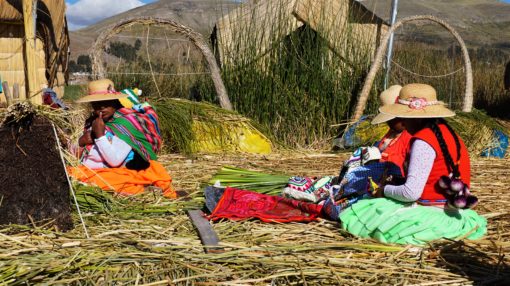
We were greeted by the family chief and sat in a circle to watch demonstrations about how the islands were constructed. The women, dressed in bright neon clothes with babies strapped to their backs, brought round bowls of fish to show us and let us taste the local produce. While the islands remain largely as they were hundreds of years ago, they now have solar panels, there are also dedicated schools and hospitals.
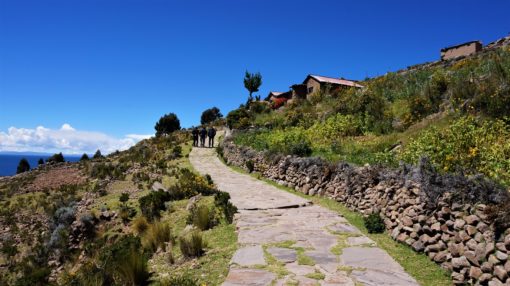
Taquile Island
Most Puno tours Lake Titicaca also include a stop at Taquile Island, where we headed next. This remote spot was once used as a prison by Spanish colonial forces before being returned to the Taquile people in 1970. With a peak of 4,050 metres, hiking across the island gave us spectacular views over Lake Titicaca as we wandered past stone houses, grazing sheep and terraces planted with potatoes and cabbages.
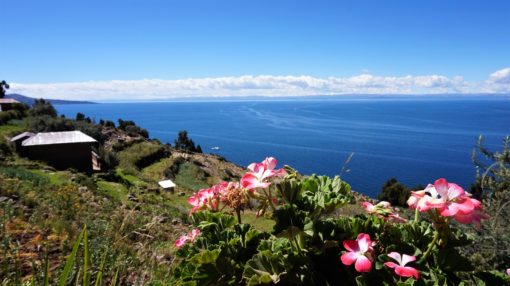
There’s no motorised transport or hotels on the island and the Taquile people are careful to preserve their traditional way of life. The tour included a lunch stop in a local house, where the family demonstrated farming techniques, traditional dances and gave us tea. Taquile is UNESCO protected for its uniquely preserved way of life and world-renowned for its beautiful textiles and handicrafts, which the family showed us along with a weaving demonstration.
Lake Titicaca travel costs
Here’s a breakdown of what we (two people) spent visiting Lake Titicaca:
| Expense | Cost for two people |
| La Cupula Hotel, Copacabana (two nights) | £61.20 |
| Ayma Hostel, Puno (two nights) | £23.50 |
| Isla del Sol boat trip | £14.40 |
| Uros Islands and Taquile Island boat trip | £22.20 |
| Extra Uros Islands boat trip | £4.40 |
| Food | £67.30 |
| Bolivia Hop Bus from La Paz to Copacabana to Puno to Cusco | £74.10 |
| Total | £267.10 |
Tips for booking Lake Titicaca tours
It’s super easy to book day or overnight trips to Lake Titicaca from both La Paz in Bolivia and Cusco in Peru. We’d recommend spending a few days visiting independently, stopping in both Puno and Copacabana. From these bases, you can:
- Book a Lake Titicaca islands tour from Copacabana to see Sun Island. It’s a two-hour round trip and at the moment, you can only visit the southern end of the island. We used the Bolivia Hop boat which goes every afternoon at 1.00 and costs £7.20 per person. You can choose to return at either 3.30 or 4.30. Local boats to Sun Island go from the dock at about 8.00 and 1.00 and return at about 4.00, costing £3 for a return trip. You can buy your tickets directly from the office at the harbour.
- In Puno there are dozens of tour companies offering day trips to the Uros Islands and Taquile, as well as homestays. Day trips normally cost between £10 and £15 and include all transport, guide and lunch. We booked through our hotel and went with Jumbo tour company at a cost of £11.10 per person for a day trip – we opted not to include lunch as there was not a vegan option so we took our own food.
You can also book tailored Lake Titicaca tours online before you visit, here are some options:
Where to stay Lake Titicaca
There are hundreds of hotels, hostels and guesthouses in Copacabana and Puno. Lake Titicaca accommodation ranges in price and quality, we always check booking sites and Tripadvisor for reviews before we book anything. Check out some top-rated hotel options for Copacabana, Lake Titicaca, for Puno, Lake Titicaca here or look at Airbnb listings. If you’ve never used Airbnb before, you can get £25 off your first stay with this link.
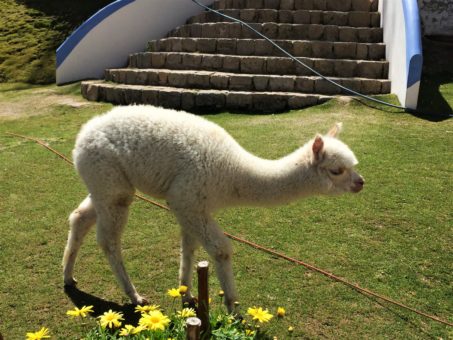
While we wouldn’t recommend the place we stayed in Puno, we loved our stay at La Cupula in Copacabana. The hotel offers rooms as well as suites with kitchens, terraces and living rooms and is set back from the main streets with aerial views of the lake. You can relax in the pretty gardens with the resident alpacas, eat in their restaurant and enjoy their friendly ginger cat.
We booked a room for £30.60 per night and used the communal kitchen to make breakfast and basic meals. There’s free tea and coffee and a lounge with TV, fire and hundreds of films to watch. While it got pretty cold in our room during the night, we were able to warm up with a heater and hot water bottles. La Cupula was truly one of the nicest hotels we’ve had in South America and we would have loved to stay longer.
Getting to and from Lake Titicaca
Following our Salt Flats tour, we flew back to La Paz and booked the Bolivia Hop bus, which has many different route options and you can hop off at different destinations along the way. We chose the La Paz – Copacabana – Puno – Cusco route, which cost £37 per person.
The journey took four hours from La Paz to Copacabana and the bus left at 6am to try and avoid road blocks around the city. A couple of days later we took the 5pm Bolivia Hop from Copacabana to Puno getting off to get our passports stamped at the Bolivian border. We then walked across to the Peru side to get our free, 90-day visa (available for British and many other nationalities) and got back on the bus for the two-hour drive to Puno.
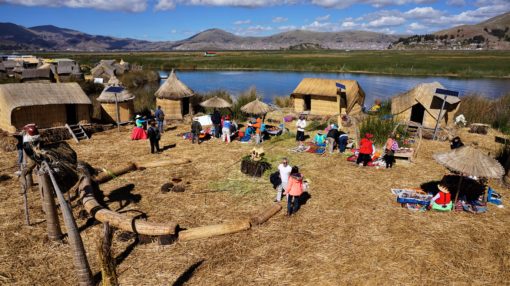
Our final journey from Puno to Cusco took 8 hours and the bus left at 10.00am. Aside from the Bolivia Hop, there are many local bus companies that offer routes to and from Lake Titicaca and can be booked online or in tour offices in La Paz and Cusco. A few popular options include:
- Tickets Bolivia (for booking online buses in Bolivia) – prices from La Paz to Copacabana vary between about £3 and £20 depending on what type of bus you take.
- Cruz del Sur (for bus journeys in Peru) – travelling from Cusco to Puno costs between £15 and £20, from Arequipa to Puno costs from £20 to £25.
- The Bolivia/Peru Hop (for journeys within and between the two countries) – a ticket from La Paz to Copacabana to Puno to Cusco costs about £37.

Pin Me For Later!
Have you been to Lake Titicaca? What did you think of it?





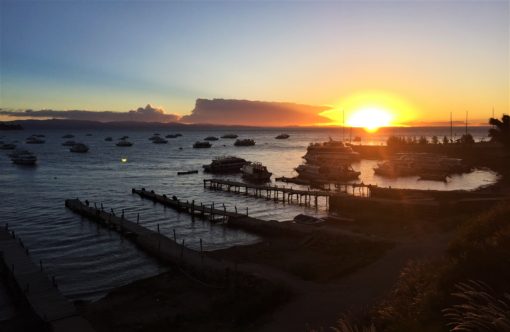
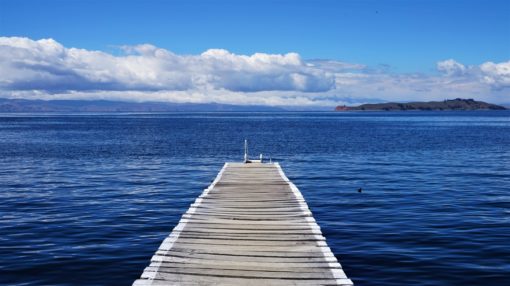
Gilda Baxter
Posted at 09:23h, 24 MayI love this post, lots of great tips here? We will be visiting this area in June. We will be staying in Puno at a bed and breakfast place. We have not yet booked a tour, would you suggest we book a tour in advance? We will only spend 2 days in Puno. I am so excited about your future plans? I have just subscribed again to receive your emails….love, love, love your blog.
Amy
Posted at 15:11h, 25 MayHi Gilda, thanks so much for your continued support and for reading our blog, we really appreciate it! We had just two nights in Puno as well and were easily able to book a tour when we arrived through our hotel. There are tons of companies and boats that go everyday, so you shouldn’t have a problem booking on arrival. You can of course organise it in advance, but it’s likely you’ll pay a bit more. Your trip is almost here now, exciting! Hope you have a great time and can’t wait to read about your impressions of Peru 🙂
Melanie Miles
Posted at 00:17h, 25 MayWow, that looks amazing. I’m not sure I’ll ever get to South America (Europe’s siren call is still too strong!) but I would definitely want to visit here if I did.
Best of luck in Portugal – thanks for your honesty and willingness to share the challenges of full-time travel with a bunch of strangers. It would be great to hear how you settle in.
Amy
Posted at 15:15h, 25 MayThanks so much Melanie for your support and kind wishes. I have much more to write about the changes ahead and why we’ve decided to move, I’m sure there will also be plenty of new Europe content too 🙂
Louisa Klimentos
Posted at 12:15h, 19 JuneA most beautiful video a beautiful lake and loving your blog a Keep up your amazing adventure love Louisa
Amy
Posted at 19:37h, 25 JuneThanks for reading and watching Louisa 🙂
Radu
Posted at 12:08h, 20 JuneGreat post! Brings back memories from when I also visited Lake Titicaca from the Peruvian side. Maybe I’ll do a retake and check out the Bolivian side, especially since I’d like to visit the salt flats. As I’ve read in your previous article, they seem amazing.
Amy
Posted at 19:38h, 25 JuneHi Radu, thanks for commenting, the Salt Flats were really incredible, one of the most unique landscapes we’ve visited. I highly recommend it!